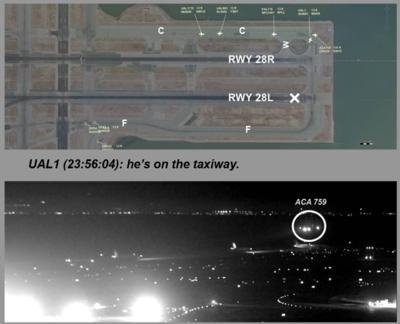Sat, Aug 05, 2017
Aircraft Came Within 85 Feet Of The Ground Before Initiation Go-Around
The National Transportation Safety Board has issued an investigative update for the July 7 near miss at San Francisco International Airport.

Air Canada flight 759, an Airbus A320, was cleared to land on runway 28R at San Francisco International Airport, but the airplane lined up on parallel taxiway C, which had four airplanes on it awaiting takeoff clearance. Air Canada flight 759 descended below 100 feet above the ground and initiated a go-around after overflying the first airplane on taxiway C.
The following facts are included in the investigative update:
- The captain was the pilot flying ACA759, and the first officer was the pilot monitoring. Both pilots held Canadian airline transport pilot certificates.
- Runway 28L was closed to accommodate construction; its approach and runway lights were turned off, and a 20.5-ft-wide lighted flashing X (runway closure marker) was placed at the threshold. Runway and approach lighting for runway 28R were on and set to default settings, which included a 2,400-foot approach lighting system, a precision approach path indicator, touchdown zone lights (white), runway centerline lights (white at the approach end), runway threshold lights (green), and runway edge lights (white at the approach end).
- The incident pilots advanced the thrust levers when the airplane was about 85 feet above ground level. Flight data recorder data indicate the airplane was over the taxiway at this time. About 2.5 seconds after advancing the thrust levers, the minimum altitude recorded on the FDR was 59 feet above ground level.
- Both pilots said, in post-incident interviews, they believed the lighted runway on their left was 28L and that they were lined up for 28R. They also stated that they did not recall seeing aircraft on taxiway C but that something did not look right to them.
- Automatic Terminal Information Service Q was current and included an advisory that runway 28L was closed and that its approach lighting system was out of service.
- Lights for taxiway C were also on and set to default settings that included centerline lights (green) along its length. Default settings also included edge lights (blue) and centerline lights (green) illuminating the transition or stub taxiways from the runway to the taxiway.
The NTSB says this investigative update does not provide probable cause for the incident and does not contain analysis of information collected thus far in the NTSB’s ongoing investigation. As such, no conclusions regarding the cause of the incident should be made from this preliminary information.
(Image provided with NTSB news release. The top portion of this graphic, created from Harris Symphony OpsVue radar track data analysis, depicts the positions of aircraft on an overhead view of the runways and taxiways at San Francisco International Airport. The text is from a transmission to air traffic control from a United Airlines airplane on the taxiway. The bottom photo, taken from San Francisco International Airport video, shows Air Canada Flight 759 passing over the United Airlines airplane.)
More News
From 2023 (YouTube Edition): "Ain’t Your Daddy’s Super Cub”—Don Wade Co-owned by Don and Ron Wade—the former of Don’s Dream Machines, a storied >[...]
Pilot-Rated Passenger Reported That The Pilot Did Not Adequately “Round Out” The Landing Flare And The Airplane Bounced And Yawed To The Right Analysis: The pilot state>[...]
Dead Reckoning Dead reckoning, as applied to flying, is the navigation of an airplane solely by means of computations based on airspeed, course, heading, wind direction, and speed,>[...]
Aero Linx: Lake Amphibian Club This website is created and sponsored by the Lake Amphibian Club, to help spread the word about these wonderful, versatile amphibians that can land j>[...]
“I am deeply honored to be sworn in as NASA administrator. NASA’s mission is as imperative and urgent as ever — to push the boundaries of human exploration, ignit>[...]
 Classic Aero-TV: In Praise of Alabamas Patriot Aircraft USA
Classic Aero-TV: In Praise of Alabamas Patriot Aircraft USA NTSB Final Report: Cirrus Design Corp SR22
NTSB Final Report: Cirrus Design Corp SR22 ANN's Daily Aero-Term (12.21.25): Dead Reckoning
ANN's Daily Aero-Term (12.21.25): Dead Reckoning ANN's Daily Aero-Linx (12.21.25)
ANN's Daily Aero-Linx (12.21.25) Aero-News: Quote of the Day (12.21.25)
Aero-News: Quote of the Day (12.21.25)



